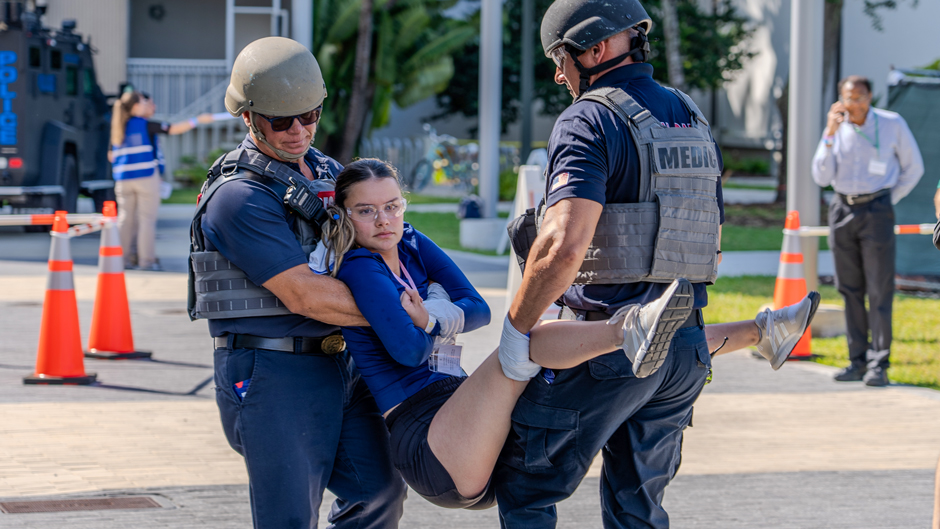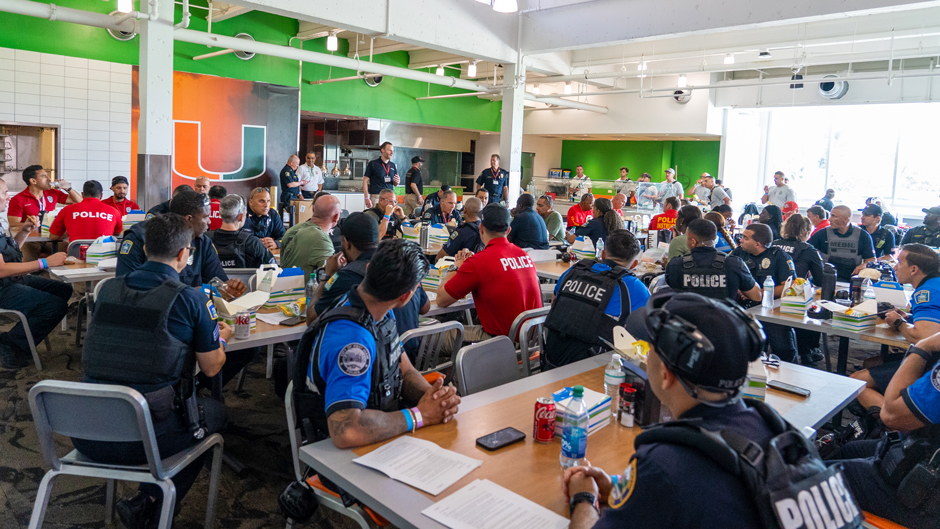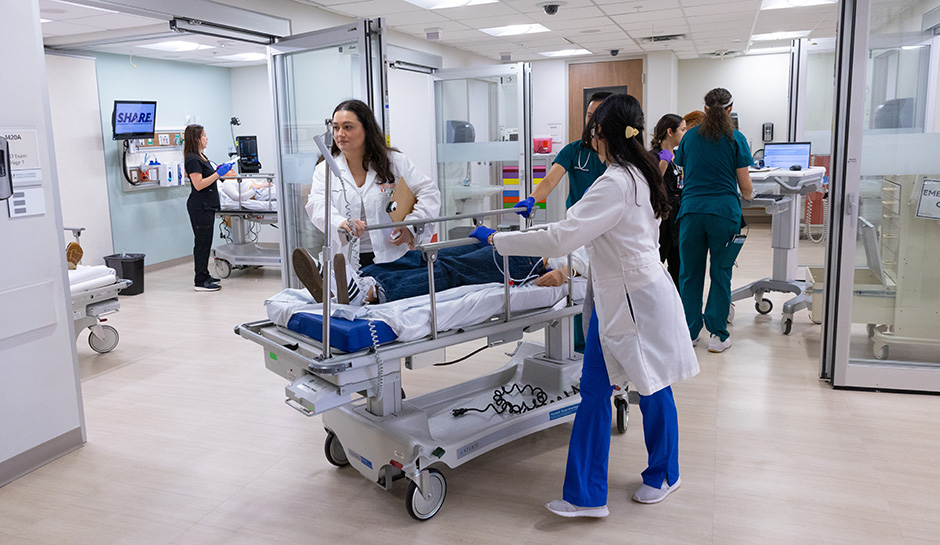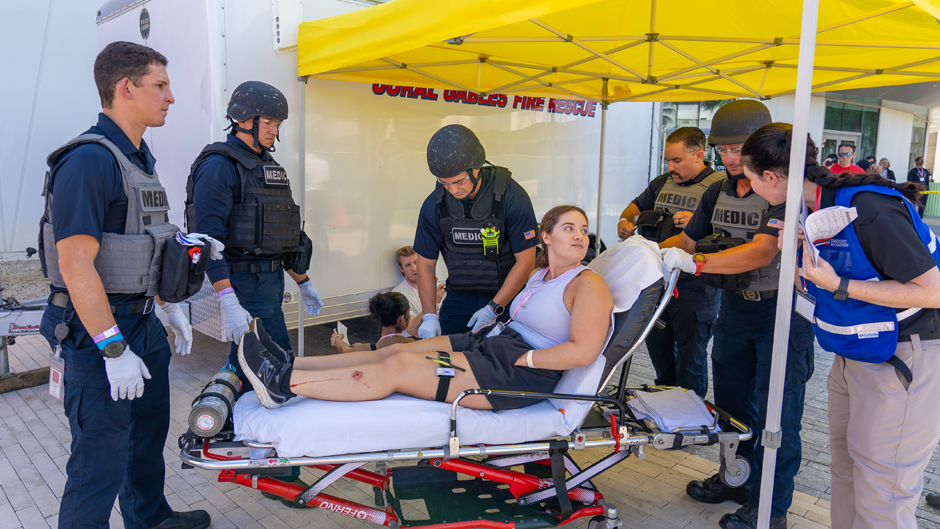In the early-morning heat of another scorching South Florida day, teams of police officers raced into the first-floor commons of the University of Miami’s Stanford Residential College.
As a small group of students fled the building, screams of “Help me!” and “I’m bleeding” rang out. Among the wounded: A male student with a gash across his chest and a female bleeding from her right arm.
A gunman was on the loose inside one of Stanford’s two towers. And officers, their weapons drawn, ascended the 12-story structures one floor at a time, conducting a methodical search for the assailant.
Eventually, they neutralized the shooter, taking him down in a coordinated multiagency effort that included law enforcement personnel from five jurisdictions.
But what looked and sounded like a real mass casualty event on the University’s Coral Gables Campus Wednesday was only a drill.

Staged by the Office of Emergency Management, the mock active-shooter exercise, codenamed Operation Phoenix, allowed first responders from a multitude of agencies to hone and sharpen their skills so that they’ll be better prepared in the event of a real active-shooter incident.
“We certainly are seeing far too many of these types of incidents in higher-education environments in our country,” said Matthew Shpiner, executive director of emergency management. “The reality of this being a threat that we must be prepared for is one that we take seriously as an institution.”
More than a dozen deadly shootings that left at least 19 victims dead occurred on U.S. college campuses last year, and the officers who took part in Wednesday’s exercise stressed the importance of preparing for such an incident.
“Regular and rigorous practice is essential for police officers to maintain and enhance their skills, ensuring they can effectively and safely perform their duties, especially regarding active-shooter response,” said University of Miami Chief of Police David A. Rivero. “Through continuous training and drills, officers sharpen their proficiency in critical areas such as using firearms and rifles in close quarters. This ongoing practice helps them stay prepared for the unpredictable nature of their work, improving their ability to make quick, sound decisions in high-pressure situations and team environments.”
In addition to the University of Miami, law enforcement personnel from the Coral Gables, Pinecrest, South Miami, and West Miami police departments participated in the drill.
Live ammunition was not used—only blanks.
It wasn’t the first multiagency training exercise conducted by the University. During the summer of 2007, some 19 agencies from across South Florida responded to a series of mock incidents on the Coral Gables Campus as part of Operation Sandbox.
“The University has been at the forefront of this for quite a while, and we’ve always been happy to partner with them,” said Coral Gables Police Chief Ed Hudak. “The coordination and resources that went into this was remarkable; everyone understood their roles. It was a tremendous learning experience.”
Six months of planning and preparation, which included a tabletop exercise, went into pulling off Operation Phoenix.
More than 200 police, fire rescue, role players, and others were involved. “The exercise lasted right around an hour and a half, although the number of hours put into setting up for and planning a successful exercise far outnumber this,” said John Gulla, director of emergency preparedness and access control.
During a 30-minute debriefing, first responders analyzed their performance, discussing ways to improve their response times and techniques.
 Melanie Peapell, a biosafety specialist for Environmental Health and Safety, was one of dozens of University employees who volunteered as role players for the event, fleeing Stanford on foot, and wearing moulage to depict injuries such as cuts, lacerations, and shattered bones.
Melanie Peapell, a biosafety specialist for Environmental Health and Safety, was one of dozens of University employees who volunteered as role players for the event, fleeing Stanford on foot, and wearing moulage to depict injuries such as cuts, lacerations, and shattered bones.
Peapell was not among the injured; she hid in a third-floor closet in Walsh Tower during the shooter’s rampage.
“I’ve participated in a lot of these drills during my lifetime. They’re absolutely necessary to help us to become better prepared if something like this, heaven forbid, ever becomes reality,” she said, echoing the sentiments of many first responders who participated in the exercise.
Paramedics and firefighters from the Coral Gables Fire Department and City of Miami and Miami-Dade County fire rescue departments cared for the injured.
The wounded were triaged in an area just outside the Knight Center for Music Innovation, with the most seriously injured transported via ambulance to the School of Nursing and Health Studies, where nursing students were put to the test in their own mock exercise—treating patients as part of a mass casualty incident (MCI) at the Simulation Hospital Advancing Research and Education (S.H.A.R.E.), which had been transformed into a Level I trauma center.
Nursing students were assigned to play scripted roles as patients and providers.
“I’m really nervous but I feel fortunate to be part of something like this,” said second-semester Accelerated Bachelor of Science in Nursing student Shayenne Vedrine, who was assigned to be a walk-in patient. “Obviously it is very beneficial training.”
At about 7:40 a.m., a group gathered in S.H.A.R.E.’s Emergency Department (ED) for a briefing ahead of the exercise. “We need to have good communication,” said Ruth Everett-Thomas, associate dean for simulation programs. “All of us are on the same team.”
Then the call came in.
An active shooter on the University’s campus had caused multiple student injuries and fatalities. An MCI was underway.
A triage tent was quickly assembled outside the entrance to the ED.
Patients began arriving soon after, first by foot, then by fire rescue. Lights flashed and sirens blared. It was just a trickle of patients at first, then a deluge.
Gunshot wounds, contusions, lacerations, head trauma. Existing patients had to be triaged. Family and friends of those believed wounded in the incident arrived at the ED requesting information about their loved ones.
 The choreography of organized chaos had begun. Students from three separate programs worked with faculty and clinical instructors to triage the injured, track their wristbands digitally to keep a record of their names, injuries, and journey throughout the hospital.
The choreography of organized chaos had begun. Students from three separate programs worked with faculty and clinical instructors to triage the injured, track their wristbands digitally to keep a record of their names, injuries, and journey throughout the hospital.
“Initially when we received the notice that we had the MCI, we called the nurse supervisor and the administrator to allocate more blood to the ED, to bring any personnel to provide additional support,” said Juan M. Gonzalez, director of the school’s Acute Care Nurse Practitioner program, who led operations for the ED.
Throughout S.H.A.R.E., clinical instructors, simulation educators, and faculty members worked together for the next two hours with acute care graduate nursing students, undergraduate accelerated nursing students, and nurse anesthesia students to respond to this simulated emergency.
In all, 20 patients, in addition to three existing non-MCI patients, had to be assessed, triaged, and transported to the proper department of the hospital for treatment from the ED: urgent care, pre-op, ICU, or surgery.
For the students at the school, this was not a professional tactical exercise. This was preparation for their careers as nurses, nurse practitioners, and nurse anesthetists.
“There are new nurses working in hospitals who have never done this before, so you guys are getting ahead of the game by doing this so early in your career,” said Vincent Torres, director of emergency preparedness for the Miller School of Medicine and UHealth – University of Miami Health System. “You’re lucky.”
The school’s involvement grew out of a previous active-shooter training and tabletop exercise led by Shpiner, said Zuzer Calero, executive director, S.H.A.R.E. business operations.
“This exercise is going to benefit many people,” Calero said.
“We took the exercise to the next level, so this would not just be the event on the ground at Stanford,” said Everett-Thomas. “We wanted to run it through the hospital as a true event. This was a great time for all of these students from different programs to work together.”
Calero added that complex communication aspects and tracking patients through the triage process in these types of MCIs were key goals. “There are so many external agencies involved that it makes it unique. It’s a simulation for the students but also for us because things are going to happen that we didn’t anticipate,” she said. “Our students will have that edge from this experience, even if it’s not exactly the same emergency they encounter in the future.”
Every time a patient came in or was moved, they had to be triaged quickly, within about 60 seconds, using the acronym RPM, which stands for respirations, perfusion, and mentation.
Clinical instructors, faculty members, and exercise leadership all praised the students for committing to their roles and collaborating so well together under a pressurized situation.
“This is unique to have this exercise in a school,” said Marco Gonzalez of the Gordon Center for Simulation and Innovation in Medical Education. “This type of training is more for an advanced learner out in the field, so this was a great experience, and you all did an excellent job.”
“We feel incredibly blessed to have the opportunity to work with the School of Nursing and Health Studies and to blend the operations of the University with an academic environment and one that is as robust as what was created here today,” said Shpiner. From day 1, the School of Nursing and Health Studies was “all in,” he added. “What we saw today is really reflective of that level of commitment.”
Coral Gables Fire Chief Marcos De La Rosa agreed. “As it was mentioned, SONHS was in it from the beginning,” he said. “Nothing beats a real-life exercise like this. This should really only be the beginning. This was very successful.”
Incoming Dean Hudson Santos thanked all of the participants and called the event “a fantastic opportunity for education and interprofessional training as well as for the growth of the school.”
Approximately 40 students from three different nursing programs and about 27 members of the school’s faculty and staff participated in the exercise on site at S.H.A.R.E.
“What we really wanted was for the students to experience how to prioritize, delegate, triage, and communicate in a situation like this,” said Nichole Crenshaw, associate dean for undergraduate nursing programs. “This was really a tremendous event.”

